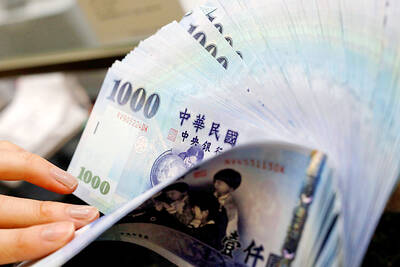The construction of Taiwan Taoyuan International Airport’s third terminal would cost more than NT$100 billion (US$3.1 billion) by the time it is completed in 2026, up from the NT$95.6 billion the government projected in May 2020, due to increases in building material costs and labor charges, the National Development Council said on Monday.
The council released the information after hearing a report from the Ministry of Transportation and Communications on the project’s progress.
The project is 52.65 percent complete and the terminal is expected to start operations in 2026, enabling the airport to serve 82 million passengers a year to help build Taiwan into an East Asian transportation hub, council Minister Kung Ming-hsin (龔明鑫) said.

Photo: Chen Hsin-yu, Taipei Times
The added cost has a lot to do with building material and labor shortages during the COVID-19 pandemic and contractors’ increased fees, the council said.
The terminal is to have a total floor space of 580,000m2 with four floors above ground and three basement floors, making it the nation’s largest public construction project in decades, the council said, adding that its roof is three times the size of the Taipei Dome.
Kung said he has asked the transportation ministry to help airport authorities with customs clearances, as well as passport, quarantine and security inspection procedures.
The ministry should also lend support to the development of neighboring areas, he said.
As of the end of last month, the nation had spent NT$370 billion on public works since the beginning of the year, the highest figure for the period over the past 16 years, the council said.
The government has budgeted NT$588.6 billion for public works next year, an increase of 0.3 percent from this year, as it aims to boost the economy, it said.

The New Taiwan dollar is on the verge of overtaking the yuan as Asia’s best carry-trade target given its lower risk of interest-rate and currency volatility. A strategy of borrowing the New Taiwan dollar to invest in higher-yielding alternatives has generated the second-highest return over the past month among Asian currencies behind the yuan, based on the Sharpe ratio that measures risk-adjusted relative returns. The New Taiwan dollar may soon replace its Chinese peer as the region’s favored carry trade tool, analysts say, citing Beijing’s efforts to support the yuan that can create wild swings in borrowing costs. In contrast,

Nvidia Corp’s demand for advanced packaging from Taiwan Semiconductor Manufacturing Co (TSMC, 台積電) remains strong though the kind of technology it needs is changing, Nvidia CEO Jensen Huang (黃仁勳) said yesterday, after he was asked whether the company was cutting orders. Nvidia’s most advanced artificial intelligence (AI) chip, Blackwell, consists of multiple chips glued together using a complex chip-on-wafer-on-substrate (CoWoS) advanced packaging technology offered by TSMC, Nvidia’s main contract chipmaker. “As we move into Blackwell, we will use largely CoWoS-L. Of course, we’re still manufacturing Hopper, and Hopper will use CowoS-S. We will also transition the CoWoS-S capacity to CoWos-L,” Huang said

Nvidia Corp CEO Jensen Huang (黃仁勳) is expected to miss the inauguration of US president-elect Donald Trump on Monday, bucking a trend among high-profile US technology leaders. Huang is visiting East Asia this week, as he typically does around the time of the Lunar New Year, a person familiar with the situation said. He has never previously attended a US presidential inauguration, said the person, who asked not to be identified, because the plans have not been announced. That makes Nvidia an exception among the most valuable technology companies, most of which are sending cofounders or CEOs to the event. That includes

INDUSTRY LEADER: TSMC aims to continue outperforming the industry’s growth and makes 2025 another strong growth year, chairman and CEO C.C. Wei says Taiwan Semiconductor Manufacturing Co (TSMC, 台積電), a major chip supplier to Nvidia Corp and Apple Inc, yesterday said it aims to grow revenue by about 25 percent this year, driven by robust demand for artificial intelligence (AI) chips. That means TSMC would continue to outpace the foundry industry’s 10 percent annual growth this year based on the chipmaker’s estimate. The chipmaker expects revenue from AI-related chips to double this year, extending a three-fold increase last year. The growth would quicken over the next five years at a compound annual growth rate of 45 percent, fueled by strong demand for the high-performance computing